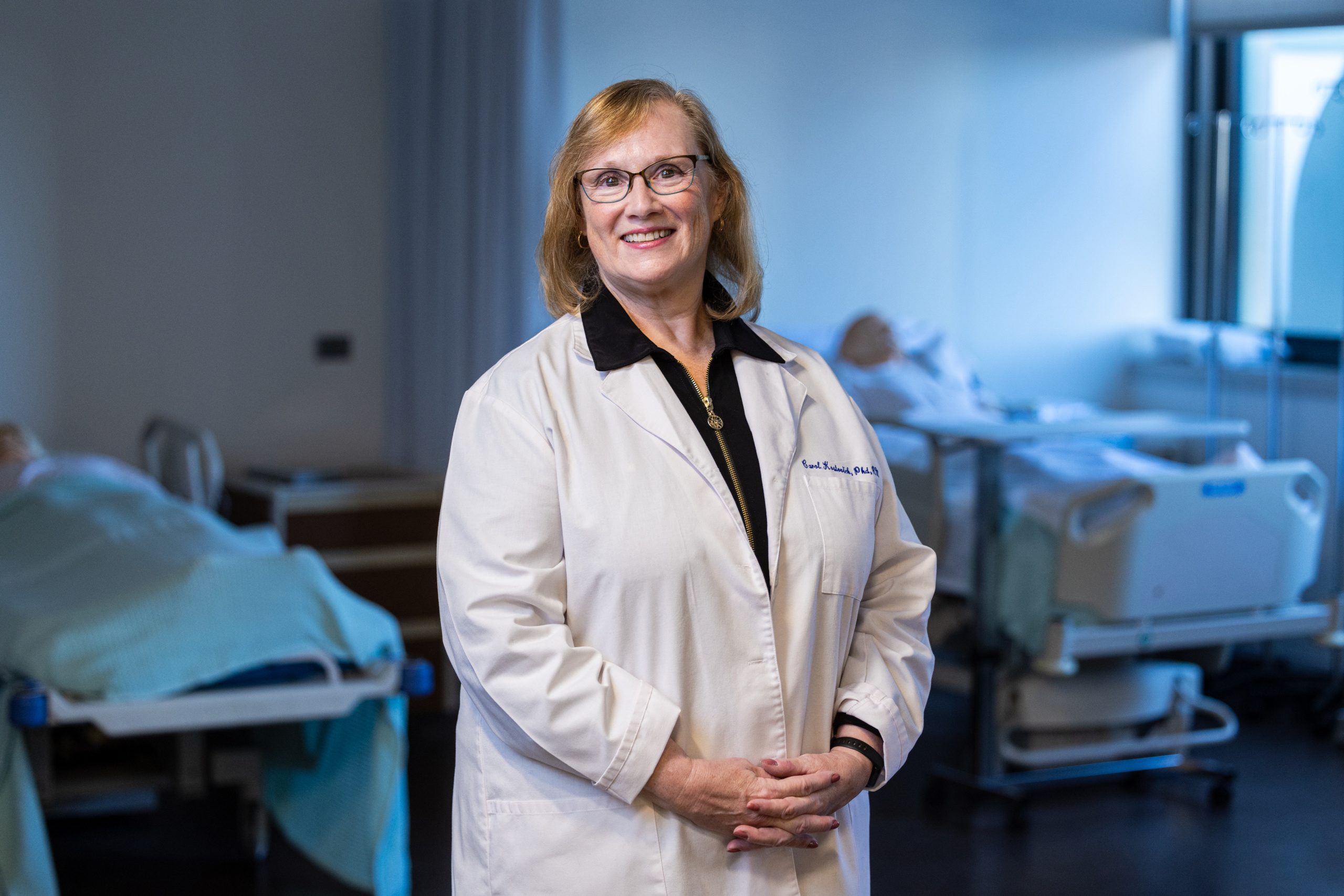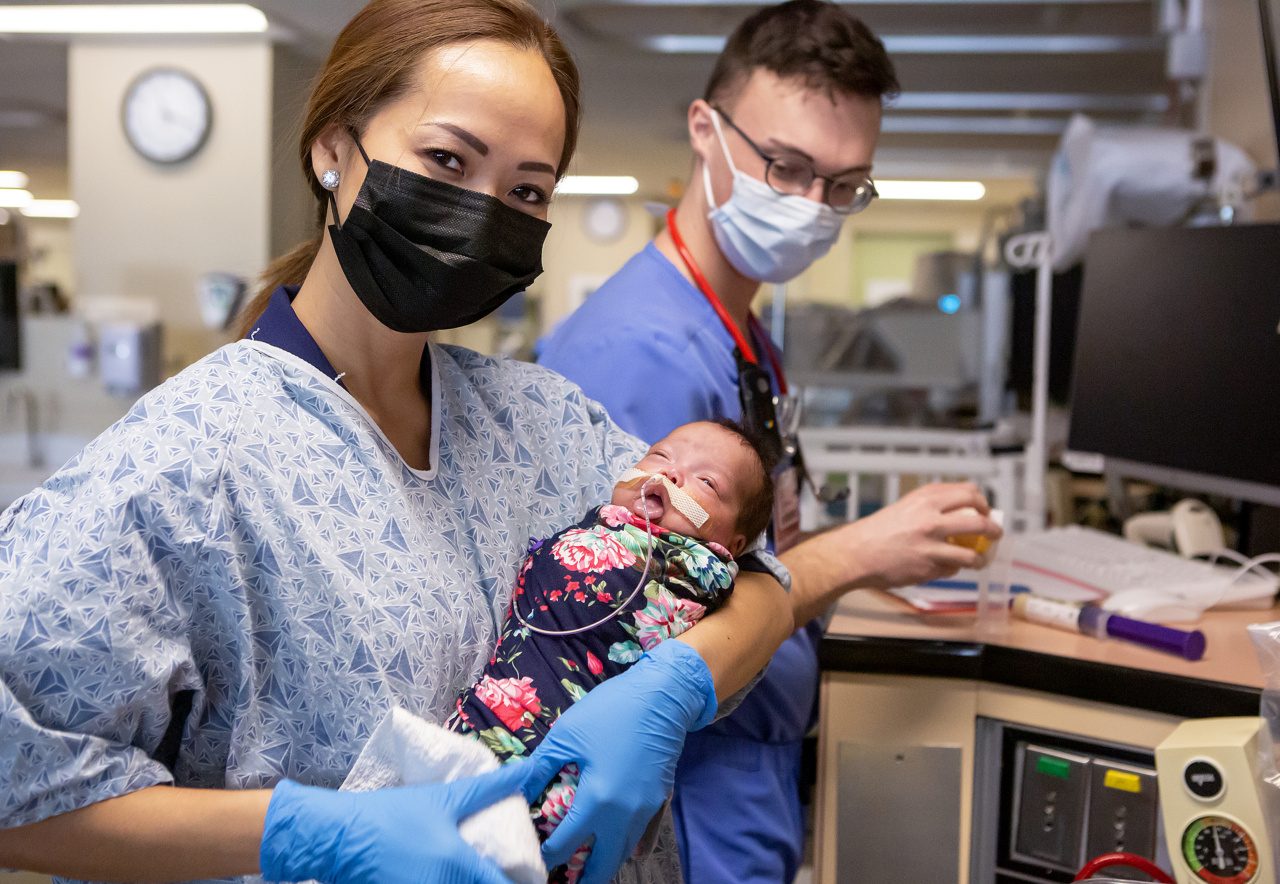
A Marcella Niehoff School of Nursing researcher and educator who studies “nursing presence”—nurses’ ability to connect with and support their patients—was inducted into the prestigious American Academy of Nursing (AAN) this month.
Associate Professor Carol Kostovich, assistant dean of innovative educational strategies and simulation, became an AAN fellow during a ceremony in Washington, D.C.
AAN fellowship is one of the highest honors in nursing, recognizing substantial contributions to nursing science and advancing public health. Fellows are selected through a competitive peer review process and induction is a significant career milestone.
Dean Lorna Finnegan said Kostovich’s scholarship and leadership in simulation reflects Loyola’s Jesuit commitment to cura personalis, or care of the whole person.
“Helping students learn and embody nursing presence means better outcomes for patients,” she said. “Dr. Kostovich’s distinctive research in this area highlights Loyola Nursing’s patient-centered, holistic approach to care and is an example of what sets us apart as a Jesuit university.”

More than a number
Kostovich oversees the simulation curriculum used by Loyola Nursing students as they practice clinical skills on lifelike, high-tech manikins and actors. In doing so, they develop the clinical judgement they’ll use when treating real patients.
Much of her work has focused on the nurse-patient relationship and how to integrate nursing presence—the ability to forge an interpersonal connection with patients—into simulation education.
“Knowing how to support a patient isn’t always intuitive, especially for undergraduates as they’re first starting to interact with patients,” Kostovich said. “By integrating nursing presence into our curriculum, we’re helping students develop the awareness and socio-emotional skills they need to become better nurses and provide better care to their patients.
“We’re reinforcing that each patient is more than a number on a board,” she added. “Each patient has a story. Connecting with the patient and listening to their story allows the nurse to provide care that is patient-centered, personifying cura personalis.”
Nursing presence emphasizes vulnerability, trust, and psychological safety. When Kostovich talks to students about presence, she highlights the need for nurses to be exceptional listeners who are attuned to patients’ emotional and spiritual needs, not just their physical symptoms.
Being present can include making eye contact, sitting down on the same level as the patient, and being genuine.
“We teach our students how to connect with patients on a human level. If you make that connection, then patients are going to tell you their stories,” she said. “They’re going to feel safe with you as a nurse and tell you what’s really going on with them. That’s how you develop a really effective plan of care.”
Each patient has a story. Connecting with the patient and listening to their story allows the nurse to provide care that is patient-centered, personifying cura personalis.
— Carol Kostovich, associate professor and assistant dean of innovative educational strategies and simulation in the Marcella Niehoff School of Nursing
A mission rooted in Jesuit values
Kostovich recalled the day her passion for nursing presence turned into a mission. She was overseeing an undergraduate who, during her first clinical experience, had been assigned to care for an elderly unhoused man with lung cancer.
The patient, however, refused to acknowledge his diagnosis and insisted that he had an infection.
After spending time with the man, the student tearfully recounted to Kostovich that the patient confided in her that he had cancer—the first time he had spoken the word—and that he would never forget her.
“With (the student’s) words, I realized that nursing presence must be part of the student learning experience and incorporated into the curriculum,” Kostovich said.
The encounter inspired her to quantify nursing presence and develop measurements so both the nurse and patient could share their perceptions of an interaction.
Kostovich developed the Presence of Nursing Scale (PONS) and the Presence of Nursing Scale-RN (PONS-RN) to measure both patient and nurse perspectives. The tools have been used by nurse researchers and graduate students in eight countries and translated into Turkish and Chinese, underscoring their cultural relevance and broad applicability.
Along with other Loyola Nursing simulation faculty, she led the development of a standardized debriefing model that incorporates the Jesuit focus on reflection and discernment into each simulation session. The debriefing model emphasizes psychological safety for students in the sim lab, where students practice nursing skills that can range from taking a blood pressure to making clinical judgements.
It can be a high-pressure situation, especially for undergraduates who are still learning to care for real patients.
“We want them to try new things,” said Kostovich, who is the founding co-chair of the international Society for Simulation in Healthcare’s inaugural affinity group promoting psychological safety. “We tell students that it’s okay to make a mistake in simulation as long as you learn from it.’”
Her ongoing goal is to strengthen nursing presence in undergraduate and graduate nursing curricula and advocate for psychological safety as a standard in academic and health care settings.
“Nursing presence is the cornerstone of the nurse-patient relationship and should be at the forefront of nursing education,” she said.
Read more stories from the Marcella Niehoff School of Nursing.



